Peidong Liu
MoCA: Mixture-of-Components Attention for Scalable Compositional 3D Generation
Dec 08, 2025Abstract:Compositionality is critical for 3D object and scene generation, but existing part-aware 3D generation methods suffer from poor scalability due to quadratic global attention costs when increasing the number of components. In this work, we present MoCA, a compositional 3D generative model with two key designs: (1) importance-based component routing that selects top-k relevant components for sparse global attention, and (2) unimportant components compression that preserve contextual priors of unselected components while reducing computational complexity of global attention. With these designs, MoCA enables efficient, fine-grained compositional 3D asset creation with scalable number of components. Extensive experiments show MoCA outperforms baselines on both compositional object and scene generation tasks. Project page: https://lizhiqi49.github.io/MoCA
E-MoFlow: Learning Egomotion and Optical Flow from Event Data via Implicit Regularization
Oct 14, 2025



Abstract:The estimation of optical flow and 6-DoF ego-motion, two fundamental tasks in 3D vision, has typically been addressed independently. For neuromorphic vision (e.g., event cameras), however, the lack of robust data association makes solving the two problems separately an ill-posed challenge, especially in the absence of supervision via ground truth. Existing works mitigate this ill-posedness by either enforcing the smoothness of the flow field via an explicit variational regularizer or leveraging explicit structure-and-motion priors in the parametrization to improve event alignment. The former notably introduces bias in results and computational overhead, while the latter, which parametrizes the optical flow in terms of the scene depth and the camera motion, often converges to suboptimal local minima. To address these issues, we propose an unsupervised framework that jointly optimizes egomotion and optical flow via implicit spatial-temporal and geometric regularization. First, by modeling camera's egomotion as a continuous spline and optical flow as an implicit neural representation, our method inherently embeds spatial-temporal coherence through inductive biases. Second, we incorporate structure-and-motion priors through differential geometric constraints, bypassing explicit depth estimation while maintaining rigorous geometric consistency. As a result, our framework (called E-MoFlow) unifies egomotion and optical flow estimation via implicit regularization under a fully unsupervised paradigm. Experiments demonstrate its versatility to general 6-DoF motion scenarios, achieving state-of-the-art performance among unsupervised methods and competitive even with supervised approaches.
Learning to Decide with Just Enough: Information-Theoretic Context Summarization for CDMPs
Oct 02, 2025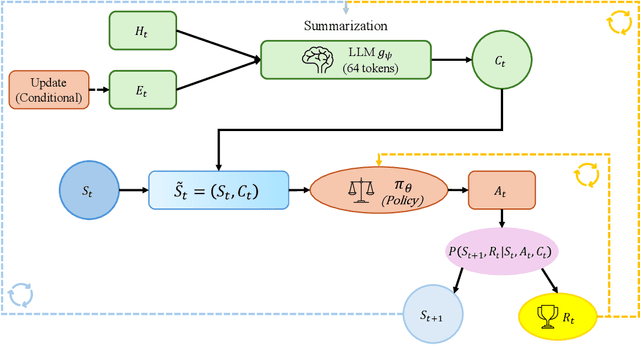

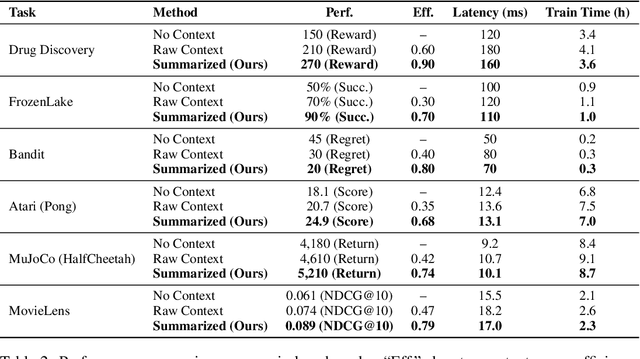
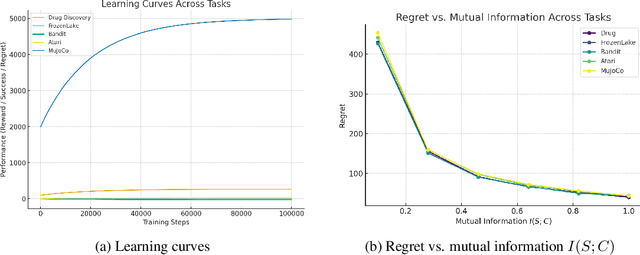
Abstract:Contextual Markov Decision Processes (CMDPs) offer a framework for sequential decision-making under external signals, but existing methods often fail to generalize in high-dimensional or unstructured contexts, resulting in excessive computation and unstable performance. We propose an information-theoretic summarization approach that uses large language models (LLMs) to compress contextual inputs into low-dimensional, semantically rich summaries. These summaries augment states by preserving decision-critical cues while reducing redundancy. Building on the notion of approximate context sufficiency, we provide, to our knowledge, the first regret bounds and a latency-entropy trade-off characterization for CMDPs. Our analysis clarifies how informativeness impacts computational cost. Experiments across discrete, continuous, visual, and recommendation benchmarks show that our method outperforms raw-context and non-context baselines, improving reward, success rate, and sample efficiency, while reducing latency and memory usage. These findings demonstrate that LLM-based summarization offers a scalable and interpretable solution for efficient decision-making in context-rich, resource-constrained environments.
SIU3R: Simultaneous Scene Understanding and 3D Reconstruction Beyond Feature Alignment
Jul 03, 2025Abstract:Simultaneous understanding and 3D reconstruction plays an important role in developing end-to-end embodied intelligent systems. To achieve this, recent approaches resort to 2D-to-3D feature alignment paradigm, which leads to limited 3D understanding capability and potential semantic information loss. In light of this, we propose SIU3R, the first alignment-free framework for generalizable simultaneous understanding and 3D reconstruction from unposed images. Specifically, SIU3R bridges reconstruction and understanding tasks via pixel-aligned 3D representation, and unifies multiple understanding tasks into a set of unified learnable queries, enabling native 3D understanding without the need of alignment with 2D models. To encourage collaboration between the two tasks with shared representation, we further conduct in-depth analyses of their mutual benefits, and propose two lightweight modules to facilitate their interaction. Extensive experiments demonstrate that our method achieves state-of-the-art performance not only on the individual tasks of 3D reconstruction and understanding, but also on the task of simultaneous understanding and 3D reconstruction, highlighting the advantages of our alignment-free framework and the effectiveness of the mutual benefit designs.
EvDetMAV: Generalized MAV Detection from Moving Event Cameras
Jun 24, 2025



Abstract:Existing micro aerial vehicle (MAV) detection methods mainly rely on the target's appearance features in RGB images, whose diversity makes it difficult to achieve generalized MAV detection. We notice that different types of MAVs share the same distinctive features in event streams due to their high-speed rotating propellers, which are hard to see in RGB images. This paper studies how to detect different types of MAVs from an event camera by fully exploiting the features of propellers in the original event stream. The proposed method consists of three modules to extract the salient and spatio-temporal features of the propellers while filtering out noise from background objects and camera motion. Since there are no existing event-based MAV datasets, we introduce a novel MAV dataset for the community. This is the first event-based MAV dataset comprising multiple scenarios and different types of MAVs. Without training, our method significantly outperforms state-of-the-art methods and can deal with challenging scenarios, achieving a precision rate of 83.0\% (+30.3\%) and a recall rate of 81.5\% (+36.4\%) on the proposed testing dataset. The dataset and code are available at: https://github.com/WindyLab/EvDetMAV.
Styl3R: Instant 3D Stylized Reconstruction for Arbitrary Scenes and Styles
May 27, 2025Abstract:Stylizing 3D scenes instantly while maintaining multi-view consistency and faithfully resembling a style image remains a significant challenge. Current state-of-the-art 3D stylization methods typically involve computationally intensive test-time optimization to transfer artistic features into a pretrained 3D representation, often requiring dense posed input images. In contrast, leveraging recent advances in feed-forward reconstruction models, we demonstrate a novel approach to achieve direct 3D stylization in less than a second using unposed sparse-view scene images and an arbitrary style image. To address the inherent decoupling between reconstruction and stylization, we introduce a branched architecture that separates structure modeling and appearance shading, effectively preventing stylistic transfer from distorting the underlying 3D scene structure. Furthermore, we adapt an identity loss to facilitate pre-training our stylization model through the novel view synthesis task. This strategy also allows our model to retain its original reconstruction capabilities while being fine-tuned for stylization. Comprehensive evaluations, using both in-domain and out-of-domain datasets, demonstrate that our approach produces high-quality stylized 3D content that achieve a superior blend of style and scene appearance, while also outperforming existing methods in terms of multi-view consistency and efficiency.
Piloting Structure-Based Drug Design via Modality-Specific Optimal Schedule
May 12, 2025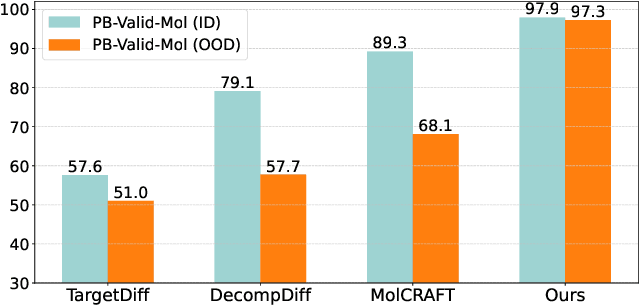
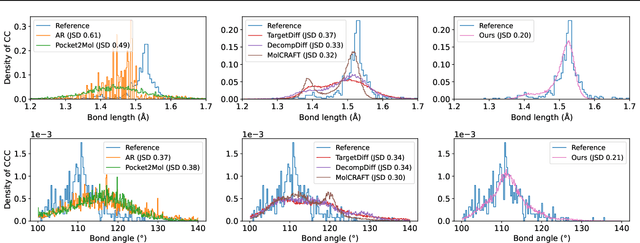
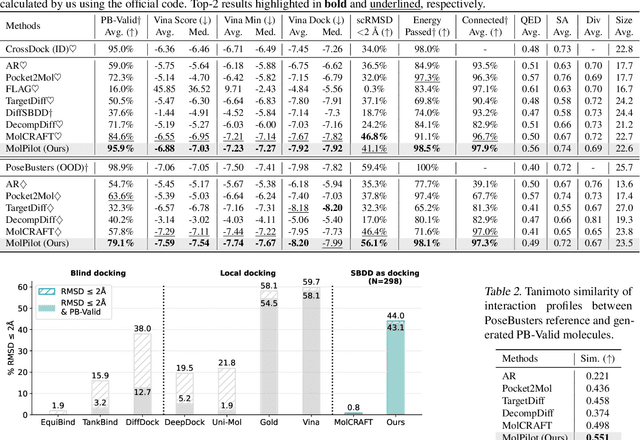

Abstract:Structure-Based Drug Design (SBDD) is crucial for identifying bioactive molecules. Recent deep generative models are faced with challenges in geometric structure modeling. A major bottleneck lies in the twisted probability path of multi-modalities -- continuous 3D positions and discrete 2D topologies -- which jointly determine molecular geometries. By establishing the fact that noise schedules decide the Variational Lower Bound (VLB) for the twisted probability path, we propose VLB-Optimal Scheduling (VOS) strategy in this under-explored area, which optimizes VLB as a path integral for SBDD. Our model effectively enhances molecular geometries and interaction modeling, achieving state-of-the-art PoseBusters passing rate of 95.9% on CrossDock, more than 10% improvement upon strong baselines, while maintaining high affinities and robust intramolecular validity evaluated on held-out test set.
Convex Relaxation for Robust Vanishing Point Estimation in Manhattan World
May 07, 2025



Abstract:Determining the vanishing points (VPs) in a Manhattan world, as a fundamental task in many 3D vision applications, consists of jointly inferring the line-VP association and locating each VP. Existing methods are, however, either sub-optimal solvers or pursuing global optimality at a significant cost of computing time. In contrast to prior works, we introduce convex relaxation techniques to solve this task for the first time. Specifically, we employ a ``soft'' association scheme, realized via a truncated multi-selection error, that allows for joint estimation of VPs' locations and line-VP associations. This approach leads to a primal problem that can be reformulated into a quadratically constrained quadratic programming (QCQP) problem, which is then relaxed into a convex semidefinite programming (SDP) problem. To solve this SDP problem efficiently, we present a globally optimal outlier-robust iterative solver (called \textbf{GlobustVP}), which independently searches for one VP and its associated lines in each iteration, treating other lines as outliers. After each independent update of all VPs, the mutual orthogonality between the three VPs in a Manhattan world is reinforced via local refinement. Extensive experiments on both synthetic and real-world data demonstrate that \textbf{GlobustVP} achieves a favorable balance between efficiency, robustness, and global optimality compared to previous works. The code is publicly available at https://github.com/WU-CVGL/GlobustVP.
CasualHDRSplat: Robust High Dynamic Range 3D Gaussian Splatting from Casually Captured Videos
Apr 24, 2025



Abstract:Recently, photo-realistic novel view synthesis from multi-view images, such as neural radiance field (NeRF) and 3D Gaussian Splatting (3DGS), have garnered widespread attention due to their superior performance. However, most works rely on low dynamic range (LDR) images, which limits the capturing of richer scene details. Some prior works have focused on high dynamic range (HDR) scene reconstruction, typically require capturing of multi-view sharp images with different exposure times at fixed camera positions during exposure times, which is time-consuming and challenging in practice. For a more flexible data acquisition, we propose a one-stage method: \textbf{CasualHDRSplat} to easily and robustly reconstruct the 3D HDR scene from casually captured videos with auto-exposure enabled, even in the presence of severe motion blur and varying unknown exposure time. \textbf{CasualHDRSplat} contains a unified differentiable physical imaging model which first applies continuous-time trajectory constraint to imaging process so that we can jointly optimize exposure time, camera response function (CRF), camera poses, and sharp 3D HDR scene. Extensive experiments demonstrate that our approach outperforms existing methods in terms of robustness and rendering quality. Our source code will be available at https://github.com/WU-CVGL/CasualHDRSplat
VicaSplat: A Single Run is All You Need for 3D Gaussian Splatting and Camera Estimation from Unposed Video Frames
Mar 13, 2025Abstract:We present VicaSplat, a novel framework for joint 3D Gaussians reconstruction and camera pose estimation from a sequence of unposed video frames, which is a critical yet underexplored task in real-world 3D applications. The core of our method lies in a novel transformer-based network architecture. In particular, our model starts with an image encoder that maps each image to a list of visual tokens. All visual tokens are concatenated with additional inserted learnable camera tokens. The obtained tokens then fully communicate with each other within a tailored transformer decoder. The camera tokens causally aggregate features from visual tokens of different views, and further modulate them frame-wisely to inject view-dependent features. 3D Gaussian splats and camera pose parameters can then be estimated via different prediction heads. Experiments show that VicaSplat surpasses baseline methods for multi-view inputs, and achieves comparable performance to prior two-view approaches. Remarkably, VicaSplat also demonstrates exceptional cross-dataset generalization capability on the ScanNet benchmark, achieving superior performance without any fine-tuning. Project page: https://lizhiqi49.github.io/VicaSplat.
 Add to Chrome
Add to Chrome Add to Firefox
Add to Firefox Add to Edge
Add to Edge